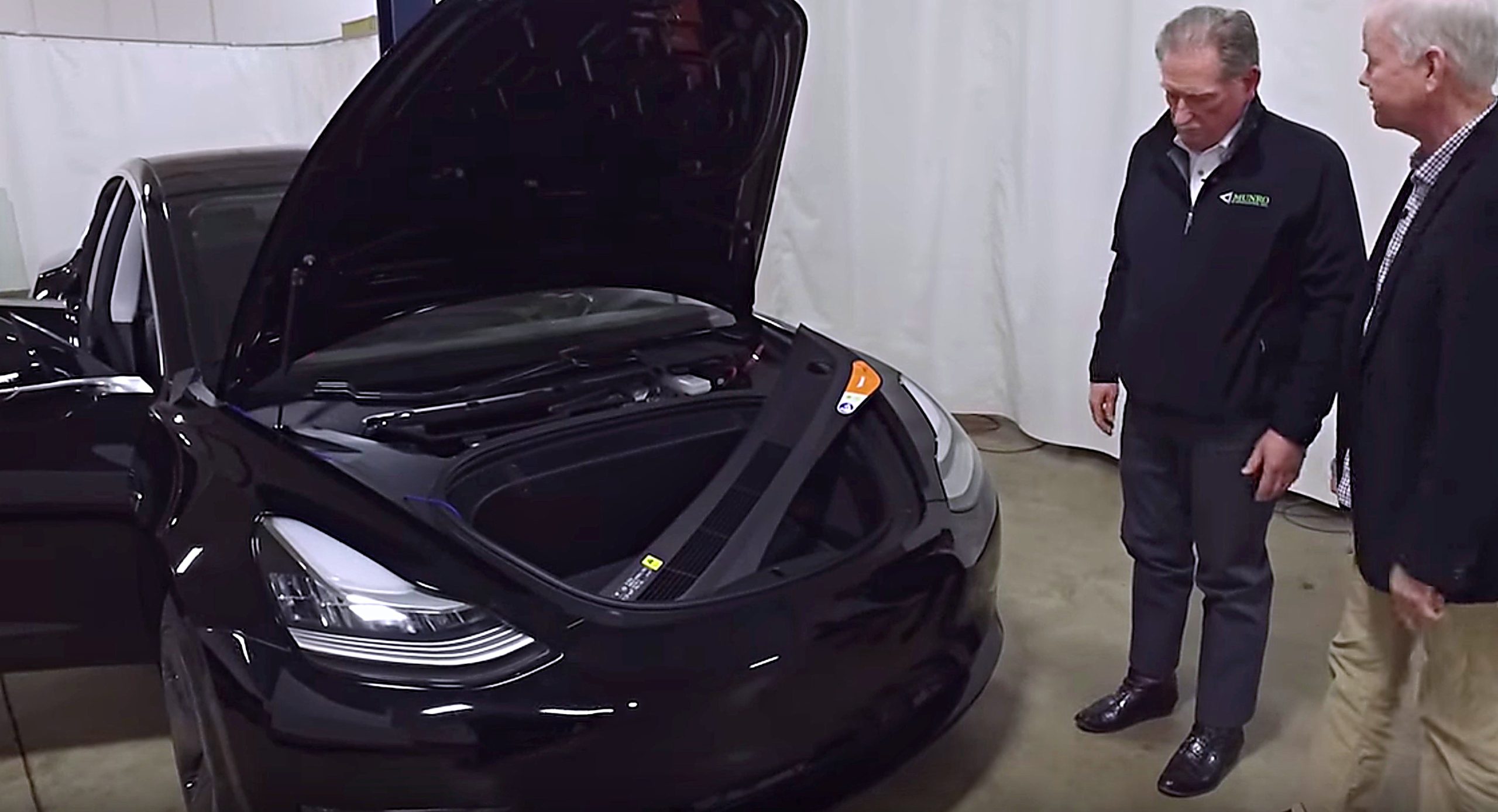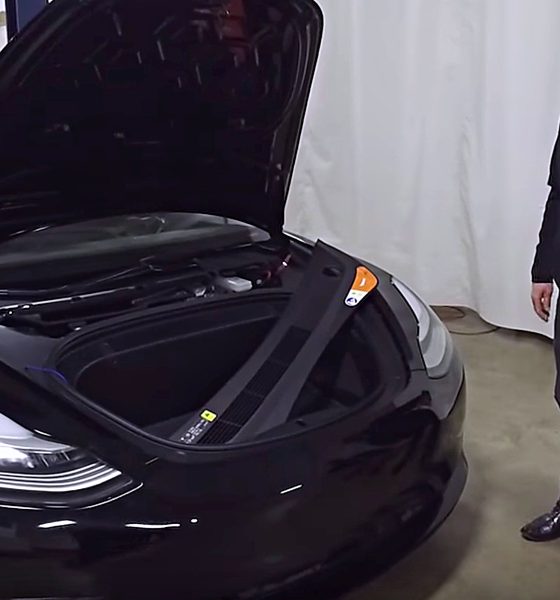

News
Tesla Model 3 gets scathing teardown review: “I can’t imagine how they released this”
Sandy Munro, CEO of Munro & Associates, an automotive benchmarking firm based in Detroit, believes that the Tesla Model 3’s build quality is incredibly lacking. In a video of his observations on the vehicle, the teardown specialist lamented on the Model 3’s apparent haphazard construction and flawed design, from its panel gaps and trunk to its non-mechanical interior rear door handles.
The automotive veteran’s comments and observations on Tesla’s vehicle were featured in a recently uploaded video from Autoline Network, where host John McElroy tackled the flaws of the Model 3 with the Detroit veteran. From a general standpoint, the Munro & Associates CEO had a lot of issues with the car’s fit and finish, with the automotive teardown expert stating that he could not imagine “how they (Tesla) released this (the Model 3).”
One particular pain point for Munro was the glaring panel gaps in the vehicle. On the rear trunk of the Model 3, the Detroit-based executive noted that some gaps were so huge, he could fit his thumb in. Using some classic hyperbole and seemingly jabbing at Tesla CEO Elon Musk’s long-term plans for SpaceX, Munro quipped that the gaps in the car could be seen all the way “from Mars.”
The Model 3’s door handles did not get any approval from the Detroit veteran, too. According to Munro, the mechanism of the front door handles on the mass market electric compact sedan is far too complicated to operate. Munro, who admitted that his wrists were previously injured in an accident, went so far as to state that the doors were “impossible” to open with one hand, and that it caused him great pain to use. The CEO summarized his comments by saying that he “hated” the car’s door handles.
Apart from the front door mechanism and the panel gaps on the Model 3, Munro also took issue with the lack of mechanical door handles for the car’s rear seats. According to Munro, the lack of mechanical door mechanisms on the rear would force passengers to crawl out of the car from the trunk in the event of an accident, which is incredibly difficult and risky. Coupled with the heavy trunk of the Model 3 and the car’s confusing cut zones for emergency personnel, the Detroit veteran noted that Tesla’s latest vehicle is a lawsuit waiting to happen.
Overall, Munro concluded that Tesla had done a really bad job with the Model 3. In the Detroit veteran’s opinion, however, the main flaw of the car was the fact that it was designed by a company that is not experienced in the auto industry at all.
“This thing is a miserable job, and we’ve come to the conclusion that these guys at Tesla are definitely electronics snobs.”
Many of the auto veteran’s statements in the recently uploaded video seem to be a deliberate attempt to damage the credibility of an otherwise critically-acclaimed car. Since Tesla has begun the deliveries of the Model 3, the mass market electric compact sedan has garnered rave reviews from multiple online publications and customers alike. While the car is not perfect in any way, the Model 3 is nonetheless hailed as a vehicle that can very well usher in a new era in transportation.
Quite interestingly, Munro’s bias does not seem to come from an anti-electric car standpoint. In the past, the auto veteran hailed the BMW i3 as a masterfully manufactured car, and he was pretty impressed with the Chevy Bolt EV, too. Perhaps the reason could be provided by Jalopnik, however, which reported that Munro & Associates’s most prolific clients are GM, Ford, and Chrysler, otherwise known as the Big Three of the legacy American auto industry.

News
Tesla FSD fleet is nearing 7 billion total miles, including 2.5 billion city miles
As can be seen on Tesla’s official FSD webpage, vehicles equipped with the system have now navigated over 6.99 billion miles.

Tesla’s Full Self-Driving (Supervised) fleet is closing in on almost 7 billion total miles driven, as per data posted by the company on its official FSD webpage.
These figures hint at the massive scale of data fueling Tesla’s rapid FSD improvements, which have been quite notable as of late.
FSD mileage milestones
As can be seen on Tesla’s official FSD webpage, vehicles equipped with the system have now navigated over 6.99 billion miles. Tesla owner and avid FSD tester Whole Mars Catalog also shared a screenshot indicating that from the nearly 7 billion miles traveled by the FSD fleet, more than 2.5 billion miles were driven inside cities.
City miles are particularly valuable for complex urban scenarios like unprotected turns, pedestrian interactions, and traffic lights. This is also the difference-maker for FSD, as only complex solutions, such as Waymo’s self-driving taxis, operate similarly on inner-city streets. And even then, incidents such as the San Francisco blackouts have proven challenging for sensor-rich vehicles like Waymos.
Tesla’s data edge
Tesla has a number of advantages in the autonomous vehicle sector, one of which is the size of its fleet and the number of vehicles training FSD on real-world roads. Tesla’s nearly 7 billion FSD miles then allow the company to roll out updates that make its vehicles behave like they are being driven by experienced drivers, even if they are operating on their own.
So notable are Tesla’s improvements to FSD that NVIDIA Director of Robotics Jim Fan, after experiencing FSD v14, noted that the system is the first AI that passes what he described as a “Physical Turing Test.”
“Despite knowing exactly how robot learning works, I still find it magical watching the steering wheel turn by itself. First it feels surreal, next it becomes routine. Then, like the smartphone, taking it away actively hurts. This is how humanity gets rewired and glued to god-like technologies,” Fan wrote in a post on X.
News
Tesla starts showing how FSD will change lives in Europe
Local officials tested the system on narrow country roads and were impressed by FSD’s smooth, human-like driving, with some calling the service a game-changer for everyday life in areas that are far from urban centers.

Tesla has launched Europe’s first public shuttle service using Full Self-Driving (Supervised) in the rural Eifelkreis Bitburg-Prüm region of Germany, demonstrating how the technology can restore independence and mobility for people who struggle with limited transport options.
Local officials tested the system on narrow country roads and were impressed by FSD’s smooth, human-like driving, with some calling the service a game-changer for everyday life in areas that are far from urban centers.
Officials see real impact on rural residents
Arzfeld Mayor Johannes Kuhl and District Administrator Andreas Kruppert personally tested the Tesla shuttle service. This allowed them to see just how well FSD navigated winding lanes and rural roads confidently. Kruppert said, “Autonomous driving sounds like science fiction to many, but we simply see here that it works totally well in rural regions too.” Kuhl, for his part, also noted that FSD “feels like a very experienced driver.”
The pilot complements the area’s “Citizen Bus” program, which provides on-demand rides for elderly residents who can no longer drive themselves. Tesla Europe shared a video of a demonstration of the service, highlighting how FSD gives people their freedom back, even in places where public transport is not as prevalent.
What the Ministry for Economic Affairs and Transport says
Rhineland-Palatinate’s Minister Daniela Schmitt supported the project, praising the collaboration that made this “first of its kind in Europe” possible. As per the ministry, the rural rollout for the service shows FSD’s potential beyond major cities, and it delivers tangible benefits like grocery runs, doctor visits, and social connections for isolated residents.
“Reliable and flexible mobility is especially vital in rural areas. With the launch of a shuttle service using self-driving vehicles (FSD supervised) by Tesla in the Eifelkreis Bitburg-Prüm, an innovative pilot project is now getting underway that complements local community bus services. It is the first project of its kind in Europe.
“The result is a real gain for rural mobility: greater accessibility, more flexibility and tangible benefits for everyday life. A strong signal for innovation, cooperation and future-oriented mobility beyond urban centers,” the ministry wrote in a LinkedIn post.
News
Tesla China quietly posts Robotaxi-related job listing
Tesla China is currently seeking a Low Voltage Electrical Engineer to work on circuit board design for the company’s autonomous vehicles.

Tesla has posted a new job listing in Shanghai explicitly tied to its Robotaxi program, fueling speculation that the company is preparing to launch its dedicated autonomous ride-hailing service in China.
As noted in the listing, Tesla China is currently seeking a Low Voltage Electrical Engineer to work on circuit board design for the company’s autonomous vehicles.
Robotaxi-specific role
The listing, which was shared on social media platform X by industry watcher @tslaming, suggested that Tesla China is looking to fill the role urgently. The job listing itself specifically mentions that the person hired for the role will be working on the Low Voltage Hardware team, which would design the circuit boards that would serve as the nervous system of the Robotaxi.
Key tasks for the role, as indicated in the job listing, include collaboration with PCB layout, firmware, mechanical, program management, and validation teams, among other responsibilities. The role is based in Shanghai.
China Robotaxi launch
China represents a massive potential market for robotaxis, with its dense urban centers and supportive policies in select cities. Tesla has limited permission to roll out FSD in the country, though despite this, its vehicles have been hailed as among the best in the market when it comes to autonomous features. So far, at least, it appears that China supports Tesla’s FSD and Robotaxi rollout.
This was hinted at in November, when Tesla brought the Cybercab to the 8th China International Import Expo (CIIE) in Shanghai, marking the first time that the autonomous two-seater was brought to the Asia-Pacific region. The vehicle, despite not having a release date in China, received a significant amount of interest among the event’s attendees.








